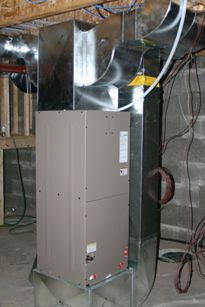Heating and Cooling
 Space cooling and heating systems account for more than 50% of a building’s total energy consumption. Pollution levels inside a traditional high-rise residential building are on average two times higher than the surrounding outdoor environment (1).
Space cooling and heating systems account for more than 50% of a building’s total energy consumption. Pollution levels inside a traditional high-rise residential building are on average two times higher than the surrounding outdoor environment (1).
The HVAC system of a building should be considered at the beginning stages of the project during an integrated design process. This allows for a more efficient and cost-effective design solution, in which other building components can be incorporated to address space conditioning issues. For example, a highly efficient building envelope can reduce the need for space heating, allowing for smaller heating and distribution equipment, thereby allowing for more usable living space.
Strategies to optimize the efficiency of the HVAC systems include the use of variable-air-volume systems to reduce energy use during part-load conditions, and economizer cycles to take advantage of free cooling with outside air within appropriate temperature bands. Ductworks used should be round or oval-shaped, appropriately sized, and adequately sealed and insulated. Using non-CFC based refrigerants is also essential to minimizing the environmental impact of the HVAC system.

